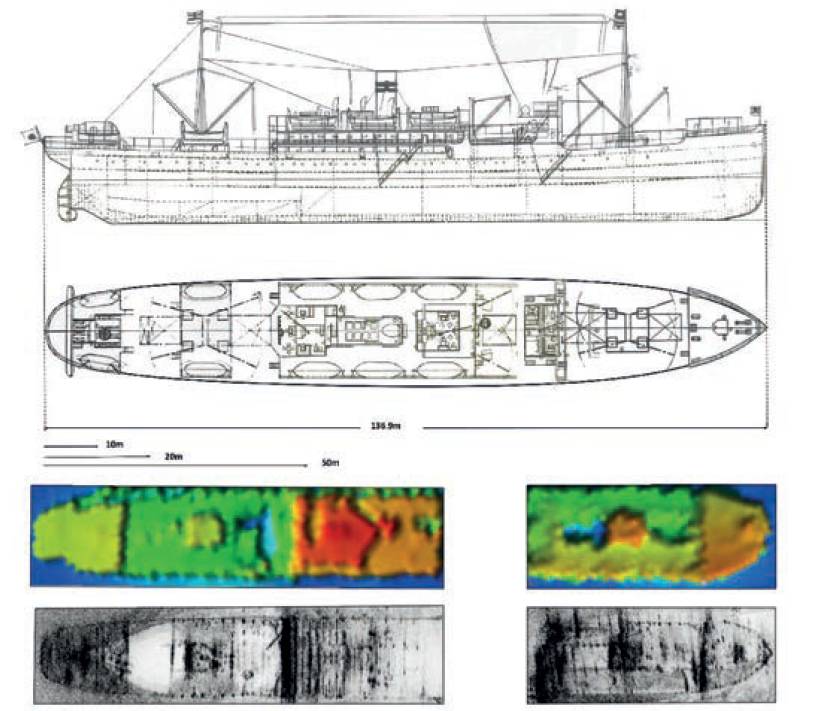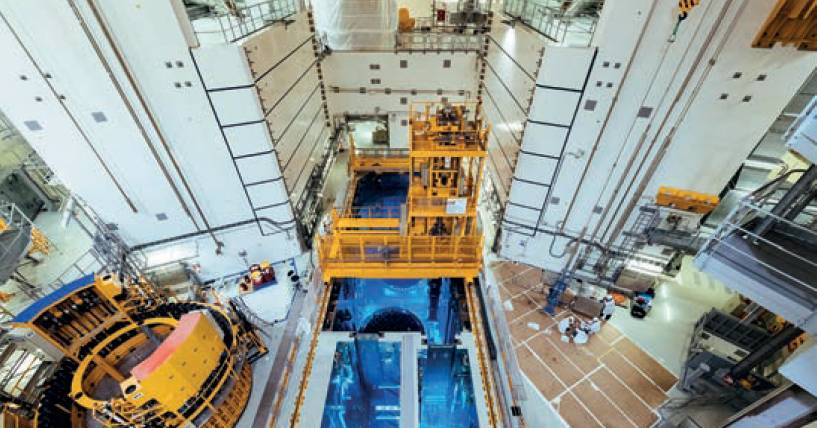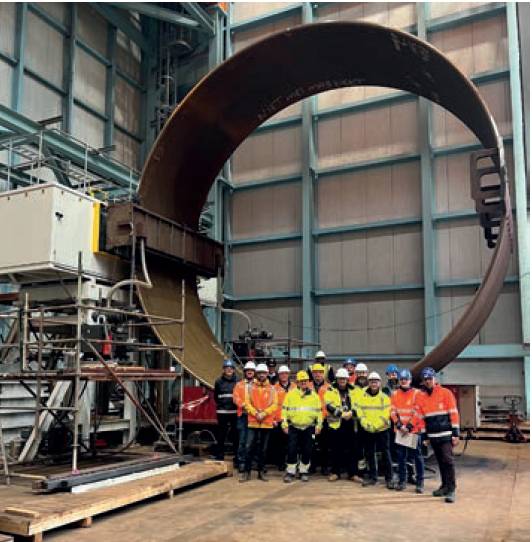Second World War ship uncovered 80 years after tragic sinking

An extraordinary mission that took nearly five years of planning, led to the location of the wreck of the Montevideo Maru, one of the worst international maritime disasters in history, to be finally revealed.
The wreckage of the Japanese transport ship was discovered at a depth of more than 4,000m off the coast of the Philippines.
It was achieved by the Silentworld Foundation and the Rabaul and Montevideo Maru Society, with support from Australia’s Department of Defence, who teamed up with Fugro and its Fugro Equator, a hydrographic survey vessel.
Deploying an autonomous underwater vehicle (AUV) with an in-built sonar, a sighting of the wreck was recorded after just 12 days, followed by its verification a few days later from maritime archaeologists, conservators, operations and research specialists, and ex-naval officers.
The Montevideo Maru was carrying approximately 1,060 prisoners of war and civilians when it was sunk by an American submarine in 1942 during the Second World War.
The tragedy resulted in fatalities from at least 14 countries, including Australia, Denmark, England, Japan, Ireland, New Zealand, Norway, and Scotland.
Autodesk’s 2023 State of Design and Make report
Research from Autodesk reveals that over half of organisations in the AECO, D&M and M&E industries worldwide are hiring employees who lack the skills needed for the job, but instead aim to provide on-the-job training to tackle the current talent shortage.
Key findings from the report include that 48% of organisations across industries cite attracting and retaining talent as a top challenge for their companies, more than any other factor, with more than two-thirds stating that their companies struggle to find employees with the right skills, and 64% said that access to skilled employees present a barrier to business growth.
The report, which surveyed more than 2,500 industry leaders from the UK, Australia, China, France, Germany, Japan, and the USA, found that 56% of organisations are hiring employees who do not have the skills needed for the job and plan to provide these employees with on-the-job training, while 67% of companies struggle to find employees with the right skills, while demographic shifts present challenges, including an ageing workforce.
As a result of these findings, organisations are trying to attract younger workers with initiatives such as four-day working weeks and enhanced maternity and paternity packages. The study shows that companies are investing in technology-focused training and hiring across geographies to solve their talent challenges. For the full report, visit www.autodesk.co.uk/insights/research/state-of-design-and-make

NASA Earth Observatory image by Lauren Dauphin, using Landsat data from the U.S. Geological Survey. Image courtesy of the NASA.
Popocatépetl Volcano keeps on puffing
One of Mexico’s most active volcanoes, Popocatépetl has been in a state of ongoing eruption since 2005, with volcanic emissions frequently billowing from its summit crater. In spring 2023, enormous plumes were captured in images acquired by satellites and astronauts, both orbiting hundreds of kilometres above Earth’s surface.
This image was acquired by the Operational Land Imager (OLI) on Landsat 8 in April. Monitoring systems on that day detected water vapor, volcanic gases, and ash, according to Mexico’s National Centre for Disaster Prevention (CENAPRED). The nearby town of Puebla. Mexico City is around 70km (40 miles) northwest of Popocatépetl.
Loughborough University students win the 2023 Bentley iTwin4Good Challenge
Organised in partnership with international non-profit organisation, Enactus the iTwin4Good Challenge with Bentley Systems has awarded ‘The Rubbish Group’ students from Loughborough University in the UK with its Enactus iTwin4Good Challenge.
The contest involved 44 students from 18 universities competing to address UN Sustainable Development Goals (SDGs), such as affordable and clean energy, sustainable cities and communities, and climate action, using the Bentley iTwin platform.
The Rubbish Group aimed to reduce littering around Loughborough University’s campus by enabling students to report where litter has been dropped using an interactive mobile app, paired with a digital twin of the campus, and a heat map log feature, to show where more litter bins are needed. The application addressed three main SDGs – good health and wellbeing, sustainable cities and communities, and climate action.
Kier Group has restructured its infrastructure services division
Kier Group will restructure its infrastructure services division to support its growth ambitions from 1 July. It means the Group’s current business streams of Highways, Utilities and Infrastructure will become two divisions – ‘Transportation’ and ‘Natural Resources, Nuclear and Networks’.
Transportation will provide works and services that support the movement of people, goods and equipment by land, sea and air, while Natural Resources, Nuclear and Networks moves with the UK into the next generation of water management, energy generation and infrastructure assets and the network distribution of essential services

Image courtesy of TVO.
Regular energy production begins at Europe’s largest nuclear reactor 18 years after construction began
Olkiluoto 3 (OL3) has finally started regular energy production 18 years after construction began. Located on an island off the west coast of Finland, construction of the OL3 reactor began in 2005 with work originally scheduled for completion in 2009, however, faced years of technical problems.
Its opening now means it has become the most powerful nuclear plant unit in Europe. It is expected to handle around 14% of Finland’s electricity needs, and will be operational for at least 60 years. It will reduce its reliance Norway and Sweden for its energy.
Power exports to Finland from Russia ended last May when Russian utility Inter RAO said it had not been paid, while Russian state-owned Gazprom also ended shipments of natural gas.
The future of England’s motorways and major A-roads mapped in new plan
As part of plans to connect the country and grow the economy in an environmentally sustainable way, the Strategic Road Network Initial Report for 2025-2030 has set out National Highways’ advice to government. It includes priorities for one of the country’s most important assets over the next five-year period and beyond.
The 4,500-mile network carries around four million vehicles a day – providing links to all major ports and airports – with continual funding needed to support the safe, efficient movement of people and goods.
The report states that National Highways’ work is likely to increasingly focus on making the most of its existing network through proactive maintenance and improvement works. This includes through greater use of digital technologies, getting the network ready for connected and autonomous vehicles and encouraging active travel.
The initial report will be subject to an eight-week consultation by the Department for Transport ending on 13 July. It will inform the government’s draft Road Investment Strategy for RP3, due to be published later this year. To find the initial report, visit www.nationalhighways.co.uk/our-roads/future-roads/strategic-road-network-initial-report/

The project team at Sif’s Maasvlakte 2 facility.
First electron beam welding of wind turbine monopile
A collaboration between Cambridge Vacuum Engineering, SSE Renewables, Sif Group, and TWI, has resulted in the first-ever electron beam welded section to be incorporated in an offshore wind turbine monopile foundation.
Instead of welding inside a costly and size-limiting vacuum chamber, Ebflow uses a local vacuum system that creates and maintains a vacuum around only the seam that is being welded.
Tested at Sif’s Maasvlakte 2 facility in Rotterdam, the monopile is now set for installation in the second phase of Dogger Bank Wind Farm, 130km off the Northeast coast of England.
Liverpool Street Station plans redevelopment in question
A campaign has been launched to stop the redevelopment of London’s Liverpool Street Station. Its original design upgrade had been met with objections from historic preservationists, with the latest which would see the original Victorian building obscured, facing fierce criticism from high profile public figures, including artist, Tracy Emin. Her name is on a letter published in The Times newspaper, calling on Levelling Up Secretary, Michael Gove to intervene and block the ‘insensitively-designed ’ plans. Developer Sellar argues the £450m plans would double the size of the station concourse and add more lifts and escalators.
The station also survived demolition in the 1970s when a campaign by then poet laureate Sir John Betjamin successfully saw the station preserved against development.
The future of machine control
Topcon has unveiled its ‘The Future of Machine Control’ report. It shines a light on machine control adoption rates and the lack of government support in its progress. This comes despite the overwhelming consensus that the technology is crucial to the industry’s ability to overcome key barriers around sustainability, skills shortages and talent. Find the report at www.topconpositioning.com/futuremachine-control-2023-report.
In brief:
- National Grid has awarded Balfour Beatty a £42m contract to construct the Little Horsted Substation Grid Supply Point in East Sussex, UK. The two-year contract will see a new 400kV substation as well as two new terminal towers.
- HammerTech, an Australian software company, which specialises in compliance, safety and site operations within construction, has expanded into the UK.
- The site investigation for Australia’s first offshore wind farm project Star of the South, located off the coast of Gippsland southeast of Australia, is to be completed by Fugro. Partly funded by the Victorian Government through the Energy Innovation Fund, it has the potential to generate up to 2.2GW of new capacity, supply around 20% of Victoria’s energy needs, and power around 1.2 million homes across the state.
- iTwin Activate, a 20-week co-development programme designed to accelerate early-stage start-ups in infrastructure engineering software, has been launched by Bentley Systems. It is managed by Bentley iTwin Ventures, a $100m corporate venture capital fund that fosters innovation by co-investing in start-ups and emerging companies.
- The European Space Agency has signed contracts for two parallel concept studies for commercial-scale space-based solar power plants led by Arthur D Little and Thales Alenia Space Italy. It represents a crucial step in the agency’s new SOLARIS initiative – maturing the feasibility of harnessing solar energy from space for terrestrial clean energy needs. They are due to be completed by the end of 2023.
- A white paper ‘Towards ecosystems of connected digital twins to address global challenges’ has been published by The Alan Turing Institute’s AI for science and government programme. It outlines important social, technical and institutional issues that must be addressed if the full potential of digital twins is to be realised.